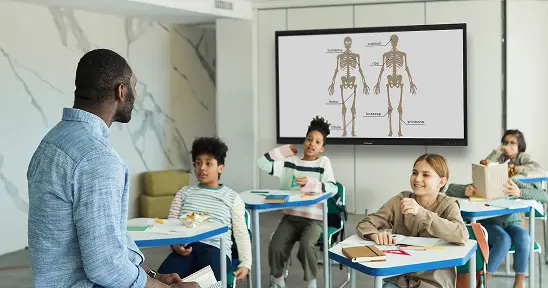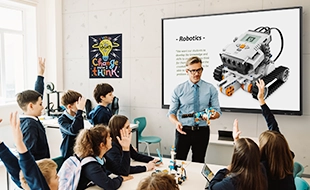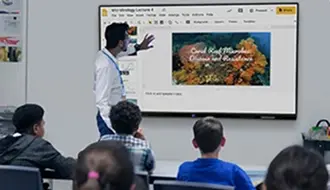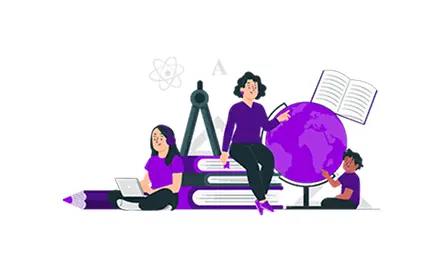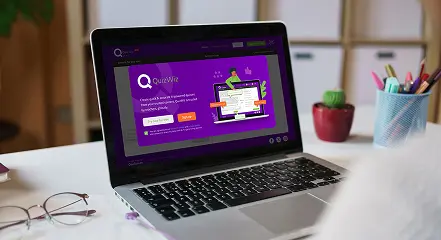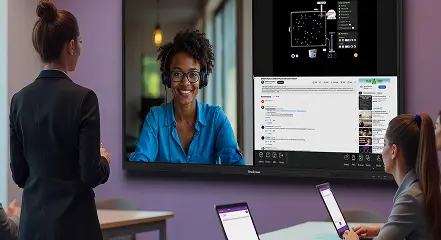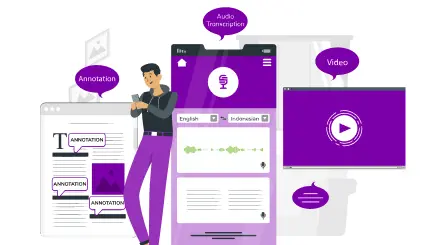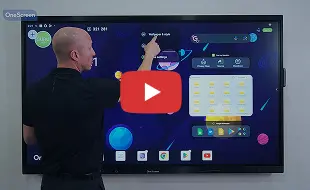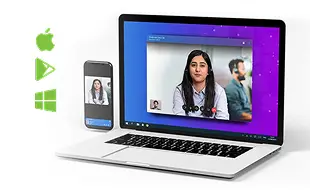
Is Tech Important in Education?
More than ever, technology in central to education. The abundance of technological tools for the classroom have grown exponentially in recent years as educators navigate remote, hybrid, and blended learning environments in the wake of a global pandemic.
However, technology in the classroom was on the rise long before it was required, and with good reason. Now that it is seemingly ever-present, we have a more comprehensive view of how it affects and enhances learning environments, as well as the possibilities it holds as technology advances. But the question remains, how important is technology to the field of education in the long term? Let’s dive into some of the ways in which it impacts the present and its implications for the future of education.
Optimized Learning Environments
With the help of technology, students are equipped to take an independent approach to their education in ways they previously could not. According to Gallup, 7 in 10 older students agree that technology helps them learn things on their own. Information is primarily digitized, and just about anything can be found online.
As a result, the digital environment becomes the learning environment — it’s how students naturally intake information. As students’ contemporary lives revolve largely around technology outside of the classroom, the lines between their exterior lives and the classroom become increasingly blurred. When information is at students’ fingertips anytime or anyplace, it results in greater continuity of the learning experience, heightening their curiosity and thirst for knowledge.
That being said, of the younger students surveyed, nearly all of them were aligned that technology made learning more fun. The use of educational games, exciting graphics, pictures, video, and even sound make for an immersive and entertaining environment that engages different learning styles and makes the classroom more collaborative. Even young children grow up using laptops and tablets, and the continuity of technology in the classroom bolsters their learning experience as a result, allowing them to interact in familiar and relatable ways.
When students’ environments reflect the contemporary technology to which they are accustomed, students are better equipped to stay engaged and retain information, as well as communicate well with each other, share ideas, problem-solve with their peers and engage critical thinking skills. With technology, students can also easily communicate with teachers when they need assistance while maintaining access to resources 24/7 and tracking their own progress digitally. A classroom fortified with technology empowers contemporary students, encouraging them to take a proactive role in their own education.
Classroom Technology as a Toolbelt
The vast majority of controversy surrounding technology in education stems from a mindset that its use in the classroom is a disruptor rather than a means by which the process of educating itself can be made easier and more individualized. According to Gallup, 77% of teachers are aligned that digital tools also help them to personalize learning according to the student, cultivating a more individualized learning environment.
In the same study, more than 75% of teachers, principals, and administrators, respectively believe that the use of digital tools in the classroom makes teachers more effective in their teaching, as well as more efficient. Because technology simplifies distributing assignments, accessing course materials, and automizes much of the grading process and record-keeping, it can help educators make better use of their valuable time for things like lesson planning and assisting students in areas where they need extra help. From a cost perspective, it also reduces the cost of physical materials and subsequently, waste.
To no fault of their own, many educators remain unfamiliar with how best to utilize digital tools to improve their classrooms. They simply have not been exposed to technology’s rapid advancements over the last decade in the same way that younger generations have and struggle to integrate it into their existing methods.
To ensure that the technology at hand is being used to its full potential, it is important for administrators to be aware of faculty’s level of familiarity when it comes to digital tools and invest in learning opportunities to advance their proficiency and optimize their existing mastery, while also incorporating technology. Especially in recent years, the learning curve is inevitable as educators adjust to reimagined learning environments, offering a time to discover what works best and implement better solutions for the future.
The Question of Accessibility
It’s impossible to honestly assess technology’s importance in the classroom without considering access to technology, which is a bit of a double-edged sword. On the one hand, technology has made education itself more accessible than ever before. The cost, especially of higher education, is significantly reduced with the advent of online programs, digital materials, flexibility, and virtual classrooms. Most scholarly articles, journals, and many books can be accessed for free and from anywhere with universities’ online databases. The use of technology has also opened up new fields of education, created jobs, and heightened demand in areas such as STEM.
At the same time, the success of digital tools is dependent upon technological equity. That is, stable internet connectivity and access to the technology itself — which can be expensive and not available to all students, or present in all classrooms, in both primary and higher education alike. Many school districts simply cannot afford to equip each of their students with laptops or tablets. And if students don’t have access to the same digital tools at home as their peers, then the quality of their education is significantly impacted as a result.
Integral Skills for Future Success
Perhaps one of the single most important implications of technology in education is the future success of students. Technology is a necessity for a future-forward curriculum. Especially in elementary and high school education, students should be proactively equipped for the next stages of both their education and subsequent careers, for which a thorough understanding of technology is critical now more than ever. According to Gallup, almost all teachers, principals, and administrators agree that there is great value in using digital tools in the classroom now, and even more so in the future. The majority also agree that digital tools aid in helping students practice solving real-world problems that they will one day face. As technology advances, so does digital transformation and the jobs emerging in today’s market follow suit. Digital tools can help students gain proficiency in the jobs they will inevitably take on, as well as empower them to pursue rapidly growing fields in technology.
Another facet of a future-forward approach to education is helping students practice digital citizenship skills. As the world becomes increasingly digitized, students can benefit from learning how best to interact with technology from an early age. It can teach them about passwords and protecting private online information, as well as about things like copyright law and intellectual property. Additionally, digital tools can teach them the importance of professionalism as they navigate different virtual spheres, such as the difference between communicating in a professional or academic context vs. communicating with their friends socially.
How Technology is Breaking Global Barriers
As digital tools continue to advance exponentially in educational technology, the future holds a multitude of possibilities that could change the lives of students all around the world. The World Economic Forum projects that the EdTech market will expand to $342 billion by 2025.
Technology helps break down many global barriers, allowing students to interact with each other regardless of location or attend schools on an entirely different continent. Tapping into technology’s global potential could continue to cultivate more diverse and culturally aware learning environments, ultimately enriching students’ lives and granting more opportunities.
As augmented reality (AR) technology continues to evolve in classrooms, curriculums become even more multi-dimensional — literally. Students can learn about the world’s geography and history as if they are literally there, sparking curiosity and inquisitiveness in an entirely new and all-inclusive way. Other forms of artificial intelligence could help educators to discover more about student performance and how their students learn best. Although these tools are on the rise, very few schools presently use them in their classrooms. However, the possibilities are endless.
Though many classrooms during the past couple of years found themselves suddenly immersed in a digital environment full of new expectations that felt tricky to navigate, they also took a giant leap into a world of digital possibility that helped to illuminate the importance of technology in education. As educators continue to learn how best to use technology to their students’ advantage, it becomes evidently clear just how essential it is to their present and future success.
Technology, when used well, is a sustainable tool to enrich the lives of both students and teachers, optimizing the learning experience in its entirety.
Sources:
Davis, V. (2014, October 24). What Your Students Really Need to Know About Digital Citizenship. Edutopia. https://www.edutopia.org/blog/digital-citizenship-need-to-know-vicki-davis
Gallup Inc. (2019). Education Technology Use in Schools. https://www.newschools.org/wp-content/uploads/2020/03/Gallup-Ed-Tech-Use-in-Schools-2.pdf
The Growing Importance of Technology in Education | UoPeople. (n.d.). University of the People. https://www.uopeople.edu/blog/the-growing-importance-of-technology-in-education/
How Important Is Technology in Education? Benefits, Challenges, and Impact on Students. (2020, June 25). School of Education Online | American University. https://soeonline.american.edu/blog/technology-in-education
Importance of Technology in Education | Allison Academy. (2021, August 7). Allison Academy. https://www.allisonacademy.com/students/education/technology-in-education/importance-of-technology-in-education/

 EN
EN  US
US  CA
CA  CO
CO  MX
MX  AE
AE  UK
UK  ES
ES  PK
PK 